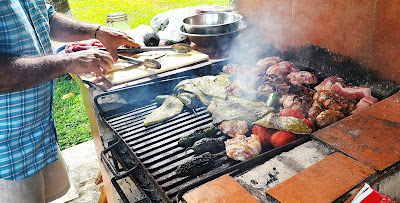I like silly things.
At least, things that are silly to me.
Pets that dress their owners in outlandish costumes. Sailing boats trimmed as Christmas trees. Or almost any Guinness record -- like the largest ball of sisal twine (in Cawker City, Kansas, if you are interested).
Apparently, some people get stuck on one definition of silly -- "showing lack of thought, understanding, or judgment." A perfectly utilitarian use of the word.
But it is not how I usually use it. "Silly" is anything that is not practical or serious. Something that will make people laugh. And anything that can make people laugh is a good thing. A silly thing.
There should be a special category of silliness for those "Ten Best" lists. You have seen them. 10 Best Places to Retire that are Ruled by Authoritarians. 10 Best Dresses Worn by Women You Never Heard of at Events No one Knew Happened. 10 Best Investments in Nigerian Commodities for People who Lost All of Their IRA on Red at Caesar's Palace. All of the lists have one thing in common -- they seem to be based on some rather eccentric criteria. Dare I say it? Silly criteria?
This morning, a headline greeted me in The Oregonian: "These are the 10 happiest countries, according to 2022 World Happiness Report." The report is produced annually by the Sustainable Development Solutions Network (a name that hints at its particular brand of political bias). And despite its "mutton-dressed-as-lamb" scientific fig leaf, the report is good for a laugh or two.
After declaring that the report is designed to measure actual well-being as opposed to national GDP (implying that money does not buy happiness), the report unveils its top 10 happiest countries for 2022: Finland, Denmark, Iceland, Switzerland, Netherlands, Luxembourg, Sweden, Norway, Israel, and New Zealand.
With all of the "beyond GDP" talk in the report, I almost expected the happiest place list to feature Haiti, Somalia, and Bangladesh. Instead, the happiest countries make up about one-quarter of the Organization for Economic Co-operation and Development (OECD), a rich-country club. It appears that money does buy happiness. (Interestingly, the top ten countries of the OECD's Happiness Index includes 8 of the same countries, adding Canada and the United States to the favored ten.)
The reason I find these reports amusing is that they attempt to morph subjective feelings into objective criteria and then weigh the frequency of positive feelings against negative ones. But that sentence sucks me into the report's number game.
These are the numbers that surprised me -- because they involve the countries with which I have the most contact. On the happiness scale, Canada is number 15. The United States is number 16. And, just for you Dan, the United Kingdom is number 17. All three bunched together.
But, my home country? Mexico? Number 46. 46! Below such paradises as Nicaragua (at 45) and Guatemala (at 39).
That alone is enough to make me doubt the objectivity of the report's findings. My frequent trips north and my conversations with Canadians and Americans here in Mexico would not support the notion that Canadians and Americans are markedly happier than the Mexicans I know. If anything, even with some of the terrible problems my Mexican acquaintances face every day, it appears to me Mexicans are far happier than the northern visitors.
And I am not talking about the Mexican mask that figures into Octavio Paz's work. I am talking about a full-throated enjoyment of what life has to offer.
Mexico is not paradise. A number of my Mexican acquaintances cringe when they hear northerners call this part of Mexico "paradise" because they know the struggle life offers. Two nights ago after leaving my house, a Mexican friend, while riding his motorcycle, was injured by a hit-and-run driver that also left his motorcycle inoperable. Without insurance for himself or his motorcycle (a motorcycle that is his sole transportation for work), the incident was a major setback.
It is just one of the many stories of hardship here. Life is often lived on the edge. But, given all of that, my Mexican friends and acquaintances have a Lake Wobegon attitude of getting up and doing what needs to be done.
I suspect what I really find silly about the happiness reports is the very word they attempt to measure. "Happiness."
It has taken living into my eighth decade to realize that the chase for happiness is just as chimeric as Johnny Depp's quest for the perfect cochinita pibil in Once Upon a Time in Mexico. To my taste, happiness is too circumstantial. Too ephemeral. Happiness, by its very nature is an emotion subject to all the tugs and pulls of all emotions.
What I am looking for, and I think I have found it, is contentment. That state of knowing you are at ease with who you are and where you are. And that circumstances cannot erode.
So, my bottom line is that the annual happiness reports provide me a chuckle or two with their silliness.
And I am content with that. Just as I am content to live my life in Mexico.


















